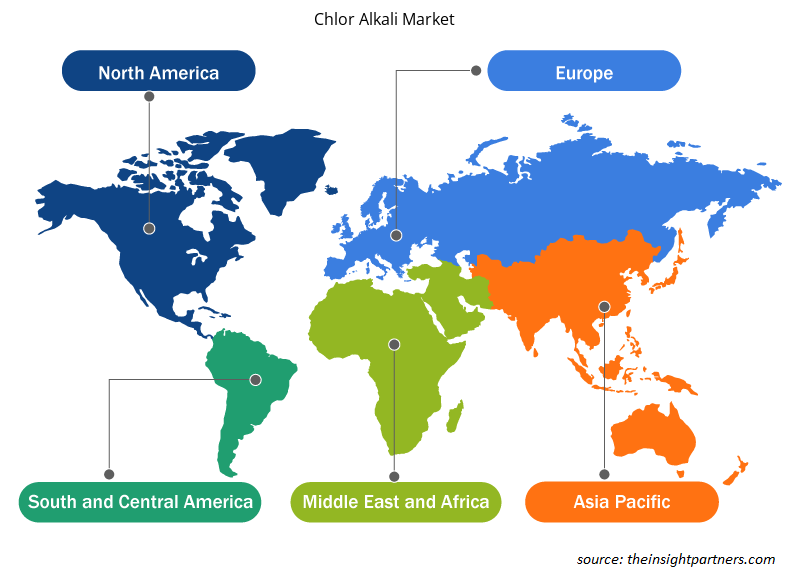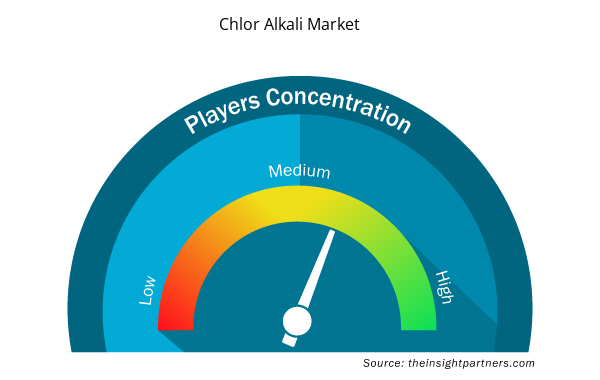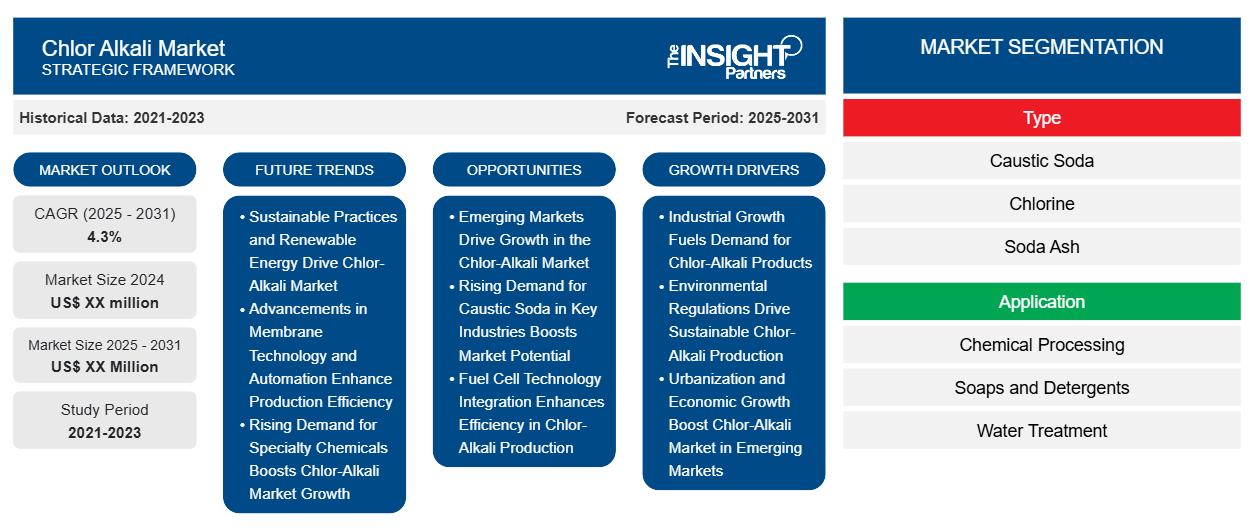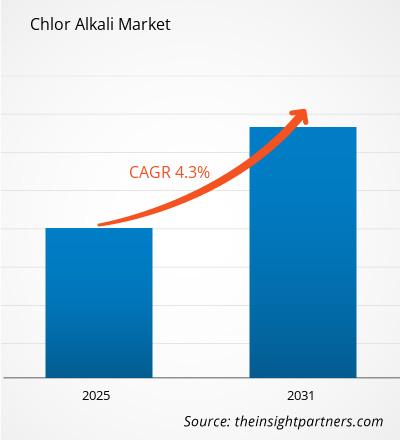塩素アルカリ市場は、 2024年から2031年にかけて4.3%のCAGRで成長し、市場規模は2024年のXX百万米ドルから2031年にはXX百万米ドルに拡大すると予想されています。
レポートは、製品タイプ(苛性ソーダ、塩素、ソーダ灰、その他)別にセグメント化されています。レポートではさらに、アプリケーション(化学処理、石鹸と洗剤、水処理、紙とパルプ、繊維、食品加工など)に基づいた分析を提示しています。レポートの範囲は、北米、ヨーロッパ、アジア太平洋、中東とアフリカ、南米と中米の5つの地域と、各地域の主要国をカバーしています。グローバル分析は、地域レベルと主要国でさらに細分化されています。レポートでは、上記の分析とセグメントに対してUSDでの価値を提供しています。
報告書の目的
The Insight Partners のレポート「塩素アルカリ市場」は、現在の状況と将来の成長、主な推進要因、課題、機会を説明することを目的としています。これにより、次のようなさまざまなビジネス関係者に洞察が提供されます。
- テクノロジープロバイダー/メーカー: 進化する市場の動向を理解し、潜在的な成長機会を把握することで、情報に基づいた戦略的意思決定が可能になります。
- 投資家: 市場の成長率、市場の財務予測、バリュー チェーン全体に存在する機会に関する包括的な傾向分析を実施します。
- 規制機関: 市場の濫用を最小限に抑え、投資家の信用と信頼を維持し、市場の完全性と安定性を維持することを目的として、市場における政策と警察活動を規制します。
塩素アルカリ市場のセグメンテーション
タイプ
- 苛性ソーダ
- 塩素
- ソーダ灰
- その他
応用
- 化学処理
- 石鹸と洗剤
- 水処理
- 紙・パルプ
- 繊維
- 食品加工
- その他
要件に合わせてレポートをカスタマイズする
このレポートの一部、国レベルの分析、Excelデータパックなど、あらゆるレポートを無料でカスタマイズできます。また、スタートアップや大学向けのお得なオファーや割引もご利用いただけます。
- このレポートの主要な市場動向を入手してください。この無料サンプルには、市場動向から見積もりや予測に至るまでのデータ分析が含まれます。
塩素アルカリ市場の成長要因
- 産業の成長が塩素アルカリ製品の需要を刺激: 塩素アルカリプロセスは、パルプや紙、繊維、水処理など、さまざまな産業で重要な役割を果たしている塩素や苛性ソーダなどの重要な化学物質を生産します。工業化の進展とインフラの発展により、これらの化学物質の世界的な需要が刺激されています。
- 環境規制が持続可能な塩素アルカリ生産を推進: 環境規制の厳格化により、持続可能性の目標に沿った塩素アルカリ製品の採用が促進されています。生産方法の進歩により、排出量と廃棄物が最小限に抑えられ、産業界はこれらの環境に優しい選択肢を採用するようになり、それが塩素アルカリ市場の成長を支えています。
- 都市化と経済成長が新興市場の塩素アルカリ市場を後押し: 新興市場における急速な都市化と経済成長により、塩素アルカリ製品の需要が高まっています。インドやブラジルなどの国で建設、自動車、消費財産業が成長していることは、塩素アルカリ生産者が市場での存在感を高める大きなチャンスです。
塩素アルカリ市場の今後の動向
- 持続可能な慣行と再生可能エネルギーが塩素アルカリ市場を牽引: 塩素アルカリ市場では、二酸化炭素排出量の最小化に重点を置いた持続可能な慣行が徐々に採用されています。電気分解と再生可能エネルギー源の使用における新たな進歩が導入されており、環境に優しい化学生産方法を求め、市場全体の持続可能性を向上させたい業界にとって魅力的です。
- 膜技術と自動化の進歩により生産効率が向上: 膜技術と自動化の最近の進歩により、塩素アルカリ生産プロセスの効率が向上しています。これらの改善によりコストが下がり、生産量が増えるため、生産能力の向上を目指すメーカーにとって、市場の競争力が高まり、魅力的なものになります。
- 特殊化学品の需要増加が塩素アルカリ市場の成長を後押し: 特に医薬品およびパーソナルケア分野での特殊化学品の需要増加が塩素アルカリ市場の成長を後押ししています。業界がより高度な用途のために高純度の塩素と苛性ソーダを求める中、メーカーはこれらの特定の要件を満たすためにプロセスを調整しています。
塩素アルカリ市場の機会
- 新興市場が塩素アルカリ市場の成長を牽引: ブラジル、中国、南アフリカ、アルゼンチンなどの国は、塩素アルカリ市場にとって大きな成長の可能性を秘めています。これらの地域では工業化と都市化が急速に進んでおり、必須化学物質の需要が高まっているため、メーカーは新規顧客を獲得し、市場での地位を強化することができます。
- 主要産業における苛性ソーダの需要増加が市場の可能性を押し上げる: 繊維、製紙、食品加工などのさまざまな分野で苛性ソーダの需要が高まっていることは、塩素アルカリ製造業者にとって大きなチャンスです。これらの産業が成長し、進化し続けるにつれて、高品質の苛性ソーダに対する需要が、市場における生産と収益の成長を促進するでしょう。
- 燃料電池技術の統合により塩素アルカリ生産の効率が向上: 燃料電池技術と塩素アルカリ生産の統合により、ユニークな機会が生まれます。水素生産と電力ユニットを組み合わせることで、メーカーはエネルギー効率を改善し、運用コストを削減し、持続可能な化学品生産のリーダーとしての地位を確立できます。
塩素アルカリ市場の地域別分析
予測期間を通じて塩素アルカリ市場に影響を与える地域的な傾向と要因は、Insight Partners のアナリストによって徹底的に説明されています。このセクションでは、北米、ヨーロッパ、アジア太平洋、中東、アフリカ、南米、中米にわたる塩素アルカリ市場のセグメントと地理についても説明します。

- 塩素アルカリ市場の地域別データを入手
塩素アルカリ市場レポートの範囲
| レポート属性 | 詳細 |
|---|---|
| 2024年の市場規模 | XX百万米ドル |
| 2031年までの市場規模 | XX百万米ドル |
| 世界のCAGR(2025年~2031年) | 4.3% |
| 履歴データ | 2021-2023 |
| 予測期間 | 2025-2031 |
| 対象セグメント | タイプ別
|
| 対象地域と国 | 北米
|
| 市場リーダーと主要企業プロフィール |
|
塩素アルカリ市場のプレーヤー密度:ビジネスダイナミクスへの影響を理解する
塩素アルカリ市場は、消費者の嗜好の変化、技術の進歩、製品の利点に対する認識の高まりなどの要因により、エンドユーザーの需要が高まり、急速に成長しています。需要が高まるにつれて、企業は提供品を拡大し、消費者のニーズを満たすために革新し、新たなトレンドを活用し、市場の成長をさらに促進しています。
市場プレーヤー密度とは、特定の市場または業界内で活動している企業または会社の分布を指します。これは、特定の市場スペースに、その規模または総市場価値と比較して、どれだけの競合相手 (市場プレーヤー) が存在するかを示します。
塩素アルカリ市場で事業を展開している主要企業は次のとおりです。
- オリンコーポレーション(米国)
- ソルベイSA(ベルギー)
- タタ・ケミカルズ・リミテッド(インド)
- オキシデンタル・ペトロリアム・コーポレーション(米国)
- アクシオールコーポレーション(米国)
免責事項:上記の企業は、特定の順序でランク付けされていません。

- 塩素アルカリ市場のトップキープレーヤーの概要を入手
主なセールスポイント
- 包括的なカバレッジ: レポートでは、塩素アルカリ市場の製品、サービス、タイプ、エンドユーザーの分析を包括的にカバーし、全体的な展望を提供します。
- 専門家による分析: レポートは、業界の専門家とアナリストの深い理解に基づいてまとめられています。
- 最新情報: このレポートは、最新の情報とデータの傾向を網羅しているため、ビジネスの関連性を保証します。
- カスタマイズ オプション: このレポートは、特定のクライアント要件に対応し、ビジネス戦略に適切に適合するようにカスタマイズできます。
したがって、塩素アルカリ市場に関する調査レポートは、業界のシナリオと成長の見通しを解読し理解する道の先導役となることができます。正当な懸念事項がいくつかあるかもしれませんが、このレポートの全体的な利点は欠点を上回る傾向があります。
- 過去2年間の分析、基準年、CAGRによる予測(7年間)
- PEST分析とSWOT分析
- 市場規模価値/数量 - 世界、地域、国
- 業界と競争環境
- Excel データセット



Report Coverage
Revenue forecast, Company Analysis, Industry landscape, Growth factors, and Trends

Segment Covered
This text is related
to segments covered.

Regional Scope
North America, Europe, Asia Pacific, Middle East & Africa, South & Central America

Country Scope
This text is related
to country scope.
よくある質問
Based on geography, Asia Pacific held the largest share of the chlor alkali market.
The report can be delivered in PDF/Word format, we can also share excel data sheet based on request.
A shift towards greener chemistry is likely to remain the key trend in the market.
Olin Corporation; Solvay S. A.; Tata Chemicals Limited; Occidental Petroleum Corporation; Axiall Corporation; AkzoNobel N. V.; Formosa Plastic Corporation; Hanwha chemical corporation; Tosoh Corporation; and Nirma Limited are among the leading players operating in the chlor alkali market.
Increasing demand for chlor alkali from various end-use industries such as chemicals, paper and pulp, textiles, detergents, among others is driving the market growth.
The Chlor Alkali Market is estimated to witness a CAGR of 4.3% from 2023 to 2031
Trends and growth analysis reports related to Chemicals and Materials : READ MORE..
The List of Companies
1. Olin Corporation (U. S.)
2. Solvay S. A. (Belgium)
3. Tata Chemicals Limited (India)
4. Occidental Petroleum Corporation (U. S)
5. Axiall Corporation (U. S.)
6. AkzoNobel N. V. (Netherlands)
7. Formosa Plastic Corporation (Taiwan)
8. Hanwha chemical corporation (Korea)
9. Tosoh Corporation (Japan)
10. Nirma Limited (India)
The Insight Partners performs research in 4 major stages: Data Collection & Secondary Research, Primary Research, Data Analysis and Data Triangulation & Final Review.
- Data Collection and Secondary Research:
As a market research and consulting firm operating from a decade, we have published and advised several client across the globe. First step for any study will start with an assessment of currently available data and insights from existing reports. Further, historical and current market information is collected from Investor Presentations, Annual Reports, SEC Filings, etc., and other information related to company’s performance and market positioning are gathered from Paid Databases (Factiva, Hoovers, and Reuters) and various other publications available in public domain.
Several associations trade associates, technical forums, institutes, societies and organization are accessed to gain technical as well as market related insights through their publications such as research papers, blogs and press releases related to the studies are referred to get cues about the market. Further, white papers, journals, magazines, and other news articles published in last 3 years are scrutinized and analyzed to understand the current market trends.
- Primary Research:
The primarily interview analysis comprise of data obtained from industry participants interview and answers to survey questions gathered by in-house primary team.
For primary research, interviews are conducted with industry experts/CEOs/Marketing Managers/VPs/Subject Matter Experts from both demand and supply side to get a 360-degree view of the market. The primary team conducts several interviews based on the complexity of the markets to understand the various market trends and dynamics which makes research more credible and precise.
A typical research interview fulfils the following functions:
- Provides first-hand information on the market size, market trends, growth trends, competitive landscape, and outlook
- Validates and strengthens in-house secondary research findings
- Develops the analysis team’s expertise and market understanding
Primary research involves email interactions and telephone interviews for each market, category, segment, and sub-segment across geographies. The participants who typically take part in such a process include, but are not limited to:
- Industry participants: VPs, business development managers, market intelligence managers and national sales managers
- Outside experts: Valuation experts, research analysts and key opinion leaders specializing in the electronics and semiconductor industry.
Below is the breakup of our primary respondents by company, designation, and region:

Once we receive the confirmation from primary research sources or primary respondents, we finalize the base year market estimation and forecast the data as per the macroeconomic and microeconomic factors assessed during data collection.
- Data Analysis:
Once data is validated through both secondary as well as primary respondents, we finalize the market estimations by hypothesis formulation and factor analysis at regional and country level.
- Macro-Economic Factor Analysis:
We analyse macroeconomic indicators such the gross domestic product (GDP), increase in the demand for goods and services across industries, technological advancement, regional economic growth, governmental policies, the influence of COVID-19, PEST analysis, and other aspects. This analysis aids in setting benchmarks for various nations/regions and approximating market splits. Additionally, the general trend of the aforementioned components aid in determining the market's development possibilities.
- Country Level Data:
Various factors that are especially aligned to the country are taken into account to determine the market size for a certain area and country, including the presence of vendors, such as headquarters and offices, the country's GDP, demand patterns, and industry growth. To comprehend the market dynamics for the nation, a number of growth variables, inhibitors, application areas, and current market trends are researched. The aforementioned elements aid in determining the country's overall market's growth potential.
- Company Profile:
The “Table of Contents” is formulated by listing and analyzing more than 25 - 30 companies operating in the market ecosystem across geographies. However, we profile only 10 companies as a standard practice in our syndicate reports. These 10 companies comprise leading, emerging, and regional players. Nonetheless, our analysis is not restricted to the 10 listed companies, we also analyze other companies present in the market to develop a holistic view and understand the prevailing trends. The “Company Profiles” section in the report covers key facts, business description, products & services, financial information, SWOT analysis, and key developments. The financial information presented is extracted from the annual reports and official documents of the publicly listed companies. Upon collecting the information for the sections of respective companies, we verify them via various primary sources and then compile the data in respective company profiles. The company level information helps us in deriving the base number as well as in forecasting the market size.
- Developing Base Number:
Aggregation of sales statistics (2020-2022) and macro-economic factor, and other secondary and primary research insights are utilized to arrive at base number and related market shares for 2022. The data gaps are identified in this step and relevant market data is analyzed, collected from paid primary interviews or databases. On finalizing the base year market size, forecasts are developed on the basis of macro-economic, industry and market growth factors and company level analysis.
- Data Triangulation and Final Review:
The market findings and base year market size calculations are validated from supply as well as demand side. Demand side validations are based on macro-economic factor analysis and benchmarks for respective regions and countries. In case of supply side validations, revenues of major companies are estimated (in case not available) based on industry benchmark, approximate number of employees, product portfolio, and primary interviews revenues are gathered. Further revenue from target product/service segment is assessed to avoid overshooting of market statistics. In case of heavy deviations between supply and demand side values, all thes steps are repeated to achieve synchronization.
We follow an iterative model, wherein we share our research findings with Subject Matter Experts (SME’s) and Key Opinion Leaders (KOLs) until consensus view of the market is not formulated – this model negates any drastic deviation in the opinions of experts. Only validated and universally acceptable research findings are quoted in our reports.
We have important check points that we use to validate our research findings – which we call – data triangulation, where we validate the information, we generate from secondary sources with primary interviews and then we re-validate with our internal data bases and Subject matter experts. This comprehensive model enables us to deliver high quality, reliable data in shortest possible time.


 このレポートの無料サンプルを入手する
このレポートの無料サンプルを入手する